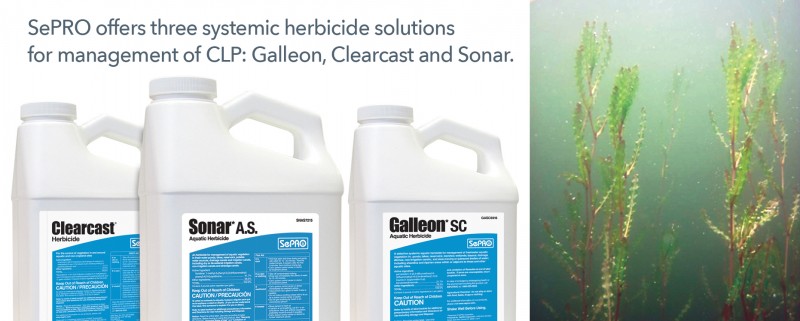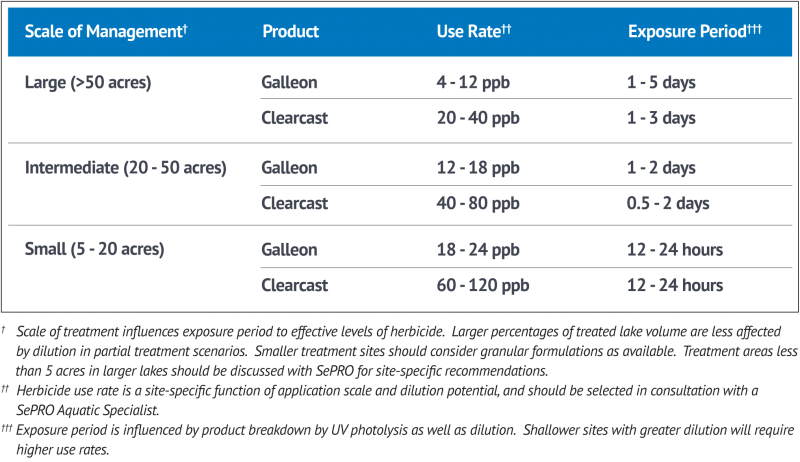Systemic Herbicide Technology for Selective Management of Curly-Leaf Pondweed
Multiple systemic herbicide solutions are available for selective management of curly-leaf pondweed (CLP - Potamogeton crispus). These solutions offer expanded options for improved long-term management of invasive CLP.
CLP is an herbaceous perennial plant that produces reproductive resting stages called turions to sustain its infestation. CLP turion production is prolific with turion counts as high as several hundred per square meter (1 - 2 million per acre) in heavily infested areas. CLP turions typically germinate in the early fall, form small plants that persist under the ice of northern lakes, which after ice-out, grow explosively to nuisance levels in the spring forming dense surface mats often covered with filamentous algae.
As CLP matures, it also forms a new season’s worth of fresh turions to continue the nuisance cycle. CLP typically senesces in the late spring/early summer, which can lead to decreased summer water quality due to release of nutrients and associated nuisance algal growth. Since turions can survive at least five years of dormancy in lake and pond sediments, best management practices using aquatic herbicides for CLP involve multiple-annual cycles of management for the control of spring growth and the long-term depletion of turions from infested sites.

Herbicide use should optimally be conducted such that little or no injury occurs to desirable native aquatic plants. Many CLP-infested sites are highly productive or eutrophic with reduced native plant diversity due to reduced water quality driven by nutrient pollution as well as CLP dominance. Non-selective CLP control prevents re-establishment of native plants to compete longer term with CLP and also may limit improvements in overall water quality without native plants to utilize nutrients released by controlled CLP and more generally by productive lake sediments.
Galleon® (a.i. penoxsulam) and Clearcast® (a.i. imazamox), are newly-developed ALS-inhibitor herbicides that target the plant-specific Acetolactate Synthase (ALS) enzyme required for production of three different amino acids key building blocks necessary for plant protein production and growth. CLP has been shown to be highly susceptible to the ALS herbicides. With early to mid-spring application, Galleon and Clearcast immediately shut down CLP growth, prevent turion production, and gradually—and very selectively—control existing CLP biomass over several weeks.
Galleon and Clearcast have different exposure times based on rate, and Galleon is the more active product on a rate for rate basis. The following chart depicts general rate ranges and exposure requirement for the two products at different scales of management,

Galleon is available currently as a liquid formulation (SC: 2 lb. active per gallon), but a 2.7% granular formulation should be available in mid-2013. Granular formulations can improve spatial targeting of aquatic herbicide treatments. Clearcast is available in both liquid (1 lb. active per gallon) and granular (2.7G: 2.7% active per lb.) formulations. Sonar® is available in multiple liquid and pellet formulations with different properties and use characteristics. Consult with a SePRO Aquatic Specialist for site and formulation-specific use recommendations.
For more information, please contact your SePRO Aquatic Specialist or call 1-800-419-7779. Visit www.sepro.com.
Galleon and Sonar are trademarks of SePRO Corporation. Clearcast is a registered trademark of BASF Corporation. Always read and follow label directions.
To enable comments sign up for a Disqus account and enter your Disqus shortname in the Articulate node settings.